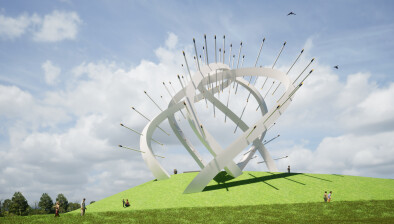And finally… Video games can help solve global design challenges, claims architect

A Los Angeles architect and game developer has claimed that video games will become an increasingly important tool for designing cities.
Jose Sanchez, who has launched a neighbourhood-building simulator called Block’hood, said games could help both professionals and the public understand the challenges of contemporary cities.
“As architects, we have been trained to think of local scales: small, medium, large and extra large,” the architect and coder told Dezeen. “But today we face global issues and we need new tools to address a new kind of scale: a planetary scale.
“By using games, we can engage a global audience in the problems that architecture is facing.”

Block’hood, which was released on March 10, is the latest game developed by Sanchez’s studio, Plethora Project, which explores the relationship between architecture and gaming.
The new game allows players to create neighbourhoods that need to take account of environmental, as well as social and economic, factors in order to flourish.
The simulator involves creating city districts from a range of predefined “blocks”. Each of these blocks have input requirements, which must be satisfied to create a sustainable neighbourhood.
“The game is based on concepts of ecology and entropy,” Sanchez said. “Blocks require inputs to survive. A tree might need water, but an apartment will need electricity, water and public space.”
“All blocks in the game have specific needs, but also produce specific outputs. By balancing the inputs and outputs of blocks in the game, a player understands the complex interdependence among city units.”

Block’hood gives gamers a range of 96 interdependent blocks from which to construct their cities. These include architectural elements such as apartments and shops, natural features including trees and bushes, and power sources such as wind turbines and photovoltaic panels.
Each block has its own range of input requirements that need to be satisfied in order to prevent decay, which can lead to structures becoming abandoned. In this case, they have to be destroyed.
“Be careful… seeking an utopian neighbourhood carelessly can lead to dystopia,” warns the game’s publicity text.
Sanchez, who was born in Chile and is an assistant professor at the University of Southern California’s School of Architecture in Los Angeles, said that gaming is becoming increasingly important to both architects and non-architects involved in the development of cities.
“I developed Block’hood from the perspective of an architect to raise issues of ecology and lifecycles of cities,” he said.
“Games do not need to be a mechanism only for entertainment. They have the power to immerse players into simulated narratives and allow for a collective thinking through virtual communities.”
“More than 90 per cent of our cities are done by non-architects,” he added. “The UN is using games like Minecraft to re-think neighbourhoods and disaster zones. I think that Block’hood is opening a door for the field of architecture, one that many other disciplines have started exploring.”

In future, Sanchez believes, video games will become powerful tools to understand complex urban design issues, and to encourage collaboration between professionals and communities.
“For me tools like Block’hood are not meant for architects only but rather to a larger community of people that might be interested in sharing and contributing to the problems cities face,” he said.
“I think we’re getting closer and closer to allowing games such Block’hood to become a tool of participation and public engagement.”
Games could one day replace the traditional design process, according to Sanchez.
“Architects today start designing by thinking of form either through drawings or models,” he said. “We don’t often start from a study of ecological dependencies. Block’hood allows to do both simultaneously, understand how form and ecology are interrelated.”
Contributions from SCN readers to our “And finally…” section are welcome – they should be sent to: newsdesk@scottishnews.com















